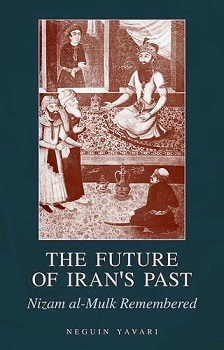The Future of Iran’s Past: Nizam al-Mulk Remembered
The Future of Iran’s Past: Nizam al-Mulk Remembered Reviewed by: David A. Meier, PhD, Professor of History, Dickinson State University Naguin Yavari’s The Future of Iran’s Past opens as a “critical study” of Nizam al-Mulk’s life (1018-92) and policies during an “age of fracture.” (xiii and xvi). Divided between five modest chapters and extensive endnotes, Yavari inquired first into the intersection of history and biography at a more theoretical level. Herodotus, Cicero, Plutarch and Julius Caesar stand among her models. Yavari drew bibliographical parallels from historical contemporary works, namely, Einhart’s Vita Karoli and Ibn ‘Abd al-Hakam’s biography of his father. Uniting all the aforementioned sources, Yavari asserted the prominence of one clear purpose, “to acclaim and memorialize.” Historiography for medieval Muslims, however, never emerged as a “formal academic study.” Such a statement makes sense in so far as Yavari intended her critical study to be more than Islamic hagiography or the life of an Islamic saint. Janet Nelson’s research into the life of Charlemagne assured Yavari that a paucity of evidence could still yield important insights into the historical personality. Unfortunately, Yavari opted not to avail herself of the rich biographical traditions embedded in Islam, especially the early biographies of Mohammad and al-Tabari’s chronicles. (xii-xix, 6-7, 14) Yavari’s second chapter noted Nizam al-Mulk’s birth in the eleventh century but diverted into the complex political machinations of the Islamic world since the days of Mohammad. Sprinkled throughout with unnecessary factoids (precisely what she claimed not to do), numerous voices lay claim to religious legitimacy while also betraying regional tribal divisions and animosities. In fact, Yavari nailed the problem to the Abbasid caliphs’ failure to construct a “legal infrastructure” and their “inability to sustain an imperial army.” (37, 60) Into this context, Yavari integrates the Abbasid caliphs Turkic slave soldiers, who appear as “hordes of uncultured barbarians.” Throughout this chapter, ethnic identities intertwined with linguistic and religious similarities. According to Nizam al-Mulk’s Suyar al-muluk, Turks served as reliable pages. (51) Turning to the Seljuqs, Yavari claims first-hand accounts of the “supernatural skills of the Saljuks and their Turkmanān armies.” (57) Labeled “Representations of Nizam al-Mulk,” Yavari’s third chapter discounted any hope of extracting details of Nizam al-Mulk’s life from existing records. Endnotes and text indicated the existence of various studies of Nizam al-Mulk and his guide for those in government, his Suyar al-muluk. Born into the landed aristocracy, Hasan, a.k.a. Nizam al-Mulk made his initial fortune as a tax-collector. His reputation as an efficient administrator propelled him into the position of vizier – or chief administrator. Consequently, Nizam al-Mulk placed his three sons in key administrative offices. Yavari credited Nizam al-Mulk’s policies with adhering to Islamic tradition, care for the poor, the creation of “Nizamiyya madrasas,” and in administering justice. (90) Yavari’s encomium extended to crediting “Nizam al-Mulk’s masterful infusion of resolute rule with godliness [which] presented the keepers of knowledge with an ideal template for good Islamic rule.” (101) Repetitive in sections, Chapter 4 aspired to define “Nizam al-Mulk and Alterity.” Hagiographic inclinations would explain Yavari’s limitless accolades for her hero. Nizam al-Mulk’s ultimate dismissal and assassination made two points unavoidable. First, Nizam al-Mulk served only at the behest of his caliph. When he became a political liability, he could be dispensed with. In this sense, the text lacks a more distanced objectively in favor of elevating Nizam al-Mulk into the ranks of Iranian patriots. Within a modest 148-pages of reading text, Yavari’s intended focus took shape in its final chapter, namely the revival of Nizam al-Mulk in modern Iran. Here we find Nizam al-Mulk possessing Plato’s cardinal virtues of “wisdom, courage, temperance, and justice.” A quick death followed those who plotted against him. He struggled with the weaknesses of his caliph, which shortly before his assassination he outlined in his Suyar al-muluk. As with any hagiography, there’s a more moral to the story: “It is Islam itself, an impersonal agent that acts to right wrongs, with the muezzin as the vessel through which Islam acts in history.” (132) In the final pages, the door opened much wider, including the involvement of the Iranian Ministry of Culture and Islamic Guidance. Iran’s Revolutionary Guards promoted Suyar al-muluk in their news website Masreq in July 2014. (140) Mysteriously, Yavari cited ‘Umar Anwar al-Zabadani’s “book-length study on Nizam al-Mulk” without clearly integrating it into her biography. (147) Yavari’s plaidoyer ended with a nationalistic twist as she commemorated Iran’s “newly acquired sovereignty that is on display in the successful nuclear negotiations with the West.” (149) In that sense, Yavari’s text speaks for itself.
|




